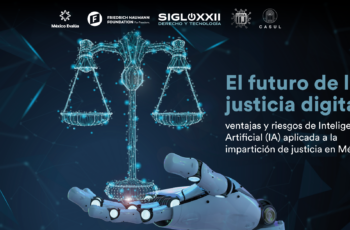The long road of digital justice in Mexico
By Laurence Pantin (@lpantin) and Sandra Escamilla (@sandritaeceron) | El Sol de México
With the arrival of the fourth wave of covid-19 in Mexico, some courts have closed their doors again and suspended deadlines and terms, as they were forced to do during much of 2020 and 2021. At that time, only a few judiciaries were able to resume their services remotely – generally those whose technological advancement had been notable since before the pandemic. Most were not prepared for it, but in any case, the health crisis left them facing a dilemma: either they took a decisive step towards digitalization or they remained paralyzed.
A good number of judicial powers opted for the first alternative. Thus, in 2019 there were 18 powers that had an electronic file; by June 2021 there were already 25 who had one. In 2019, only eight judicial powers had a platform for filing lawsuits and/or promotions online, while by 2021, there were already 16.
That does not mean that the interest of the authorities in the subject has increased. What you have just read does not come from a study carried out by a public institution, but from the diagnosis of the implementation of technological tools in judicial powers in Mexico, which was done through the Transparency in Justice program in Mexico Evalúa and published on February 9th.
What did we find? A contrasting landscape. The implementation of technological tools has occurred in a differentiated manner, not only between judicial powers but also between courts of the same Judicial Power. While there are a few judicial powers that have managed to implement these tools for all their courts and in all their matters, in others the few technological solutions implemented are focused on courts in the capital, since the most remote communities generally do not have the necessary infrastructure to adopt them.
Why is it important for judicial powers to implement this type of tool, even though some services have already begun to resume in person? First, because we are not safe from a new crisis that closes the doors of the courts again. But let’s look further: these tools have great potential to transform justice systems, reduce costs and streamline processes. For example, the digitalization of files has brought savings both for the judiciary – think of what it costs them to print – and for the user, who can consult the files without having to go to court. It also decreases the duration of the processes. For example, in Guanajuato, hearings by videoconference have made judges more efficient, since they are no longer dependent on the availability of a physical courtroom.
Finally, technological tools can reduce the backlog of judicial matters. INEGI data show that in 2020 the number of cases entered and concluded in the first instance was the lowest since 2011, the first year in which this data was recorded. And although we still do not have the data for 2021, everything indicates that part of the issues that were not filed during the pandemic were submitted last year, when face-to-face activities began to resume. This implies that the courts will face an enormous workload in the coming years. Here the big losers are not only the judicial officials, but also the users, since the delay in the resolution of matters leaves them without the possibility of accessing justice.
It is a decisive moment for all judicial powers to digitalize their services, if we want to prevent access to justice from being a reality only for some people.









